At first glance, Aihole appears to be a rather nondescript village. Dusty roads, dry summers, curious glances, cows ruminating nonchalantly on the roadside, corn drying right on the main roads – it exhibits features common to every other village of northern Karnataka. And yet, Aihole is so much more, with a rich history dating back to the second half of the 6th century.
The architectural diversity and brilliance found in our country know no bounds. Aihole is a paragon in this regard. It is a flag-bearer of India’s heritage of temple architecture. Under the royal patronage of the Early Chalukyas, Aihole served as a school of art and architecture, where artists learned techniques and honed their skills. In addition, it flourished as a center of the architectural revolution, where artists and craftsmen pursued new methods and devised innovative ideas. After completing their education, they traveled to different parts of the country, carrying along with them the knowledge and skill acquired at Aihole. Hence, Aihole has been rightly called the “cradle of Hindu temple architecture”.

Table of Contents
Where is Aihole located:
Aihole is located in the Malprabha river valley in the Bagalkot district of northern Karnataka. The distance of Aihole from some important places is as follows:
From Bengaluru: 445 km
From Badami: 35 km
From Pattadakal: 10 km
From Hampi: 138 km
How to reach there:
Aihole does not have any rail station or airport.
- By railway: Badami is the nearest railway station. It is well-connected with Bengaluru and Mysuru.
- By air: The nearest airport is Hubli, which is around 106 km away. Daily flights are available from Bengaluru to Hubli. From Hubli, you need to hire a cab for reaching Aihole.
As for us, we visited Aihole from Hampi by road.

What is the best time to visit Aihole:
The weather in Aihole is mostly hot for the most part of the year. It’s best to visit from October end up to February.
Where to stay in Aihole:
There are no such hotels or guesthouses in Aihole. You need to stay at Badami and visit Aihole on a day trip.

Aihole in mythology:
In the ancient era, Aihole was known as ‘Ayyavole’ and ‘Aryapura’. Later, the British archaeological reports referred to Aihole as ‘Aivalli’ and ‘Ahivolai’.
Mythology has associated Aihole with Parashurama, the 6th incarnation of Vishnu. It is believed that, after destroying the Kshatriyas, Parashurama washed his blood-stained axe in the Malprabha river. As the river turned red from blood, the sage screamed “Ai! Hole” (Ah! The river!). Hence came the name Aihole.
Another version is that an old lady shouted “Ayyo, Hole” (Oh no! Blood!) at the sight of the red water of Malprabha. Thus, Aihole got its name.

Aihole in history:
The history of Aihole dates back to pre-historic times. This is evident from the existence of dolmens or burial chambers, and paintings and pictographs on the walls of rock shelters. They belong to the Paleolithic, Microlithic, and Megalithic periods.
Many centuries later, Aihole rose to prominence under the patronage of the Chalukyas of Badami. From 6th to 8th CE, Aihole became a cultural center for architectural innovations and experimentation. It gave birth to a new style of architecture, which was distinctive from the Gupta style.
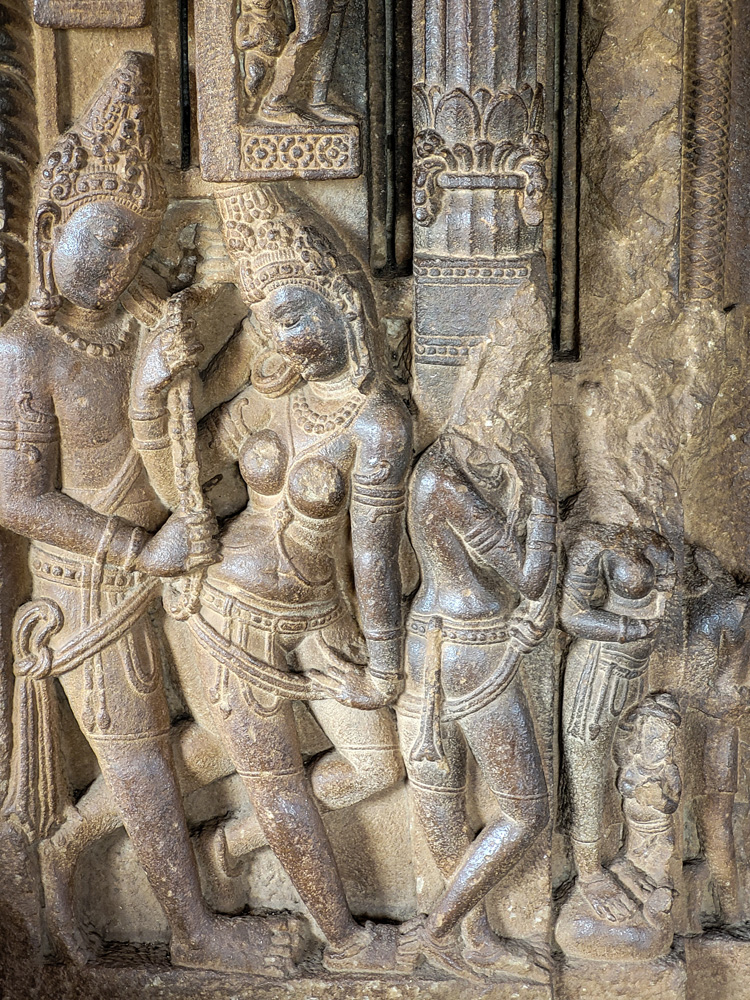
What to see in Aihole:
Aihole is home to hundreds of temples, most of which are Hindu and a few Jaina. It is estimated that there are at least 120 temples in Aihole. These temples are carved out of yellow sandstone. They belong to two distinct eras: Early Chalukyas and Rashtrakutas from the late 6th to 8th centuries, and Late Chalukyas extending over the 11th to 12th centuries.
You can notice that temple architecture in Aihole is characterized by lots of variety in styles. It is rather interesting to note that, this concentration of multiple styles within a single area can hardly be found elsewhere in India.

How long does it take to visit Aihole:
Given the vast number of temples that have survived the test of time, ideally, you should reserve an entire day for Aihole. In case your time is limited, like us, keep half a day. It will be sufficient to cover the most significant of the temples.
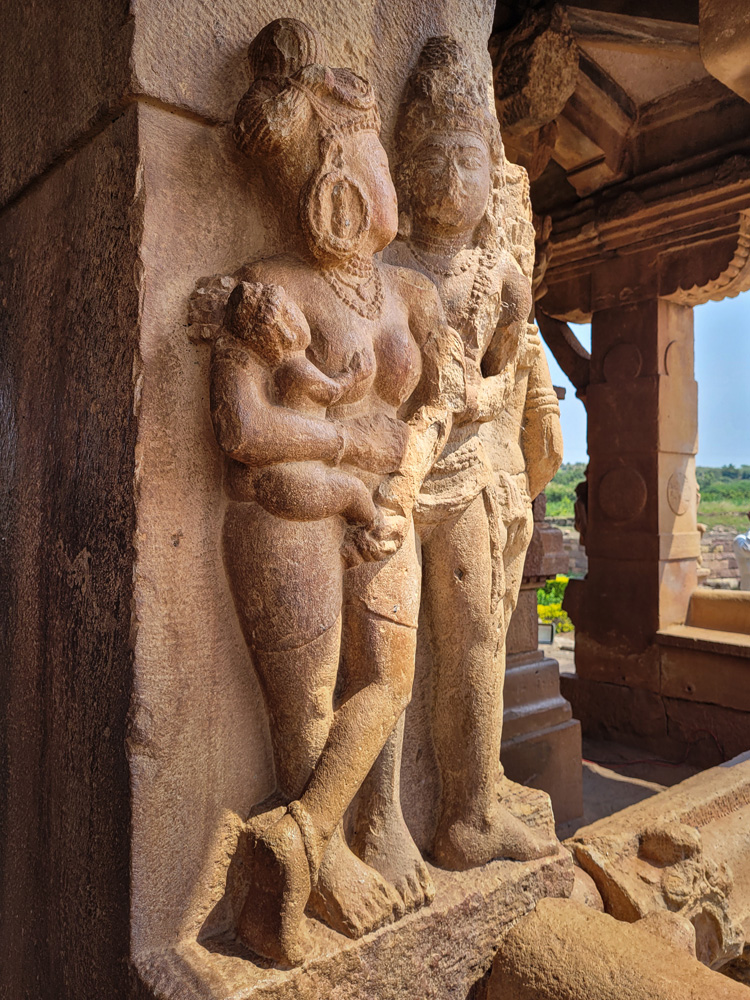
What are the important temples to visit:
We are providing here a list of important temples in Aihole. We ourselves were unable to visit all, partly because most of them were locked and partly because our schedule was tight. We hope that this list will give ideas to you while planning for your trip here.
The Durga Temple Complex:
The Durga Temple complex is the most well-preserved among all the monuments in Aihole. Naturally, this is also the most popular and attracts countless tourists, especially on the weekends and holidays. This complex has 4 main temples and also the Archaeological Museum.
Durga Temple:
The most iconic of all the religious structures in Aihole is definitely the Durga Temple. The name, however, is a misnomer. It was originally dedicated to Surya, the Sun God. The name Durga was derived from ‘durg’ or fortified lookout which was raised upon its roof.

The temple belongs to the 8th century. It was built in ‘gajaprishtha’ or elephant’s back style. It has a unique apsidal or round-ended shape.
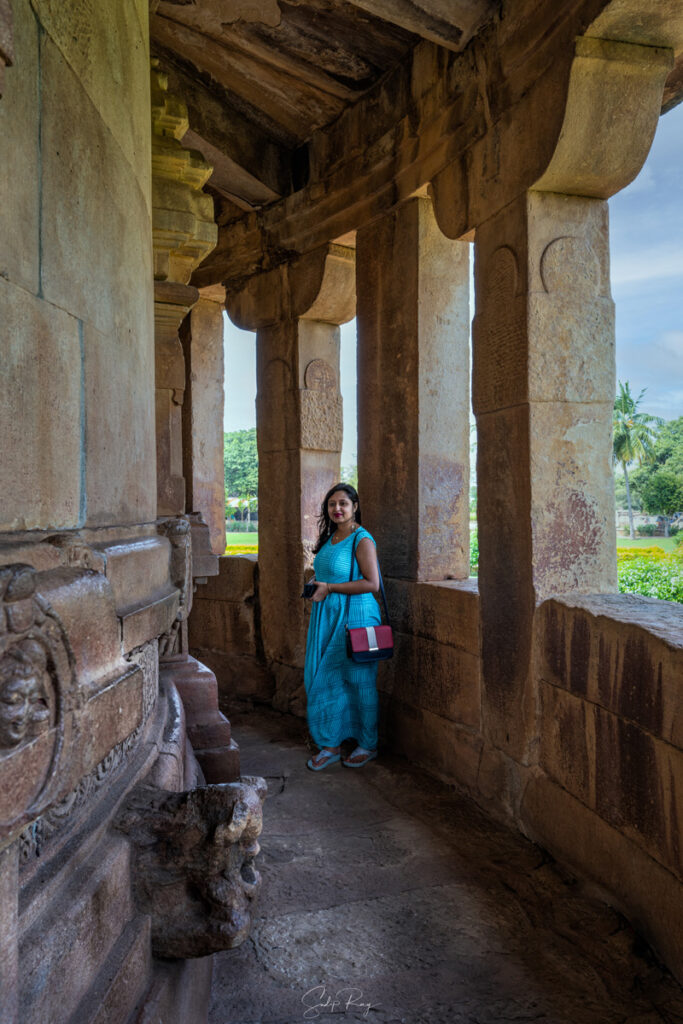
The distinctive feature of Durga Temple is the colonnaded verandah, which continues around the sanctum sanctorum creating a passageway for circumambulation. This path has spectacular sculptures of Shiva, Vishnu, Varaha, Harihara, Narasimha, and Mahisasurmardini. Faint remnants of paintings still exist. Check out the parrot motifs above the first window from the left.



The rectangular ‘sabhamandapa’ is filled with exquisite sculptures, showing the brilliant craftsmanship of Chalukyan sculptors. Notable are the Garuda on the top, and the Ganga and Yamuna on both sides of the doorframe. The ceiling has sculptures of symbolic representations of the Matsya avatar of Vishnu and Adisesha.

Lad Khan Temple:
The next interesting piece in the Durga Temple Complex is the Lad Khan Temple. The temple is named after a Muslim commander of Adil Shahi Sultanate, who used to stay here.
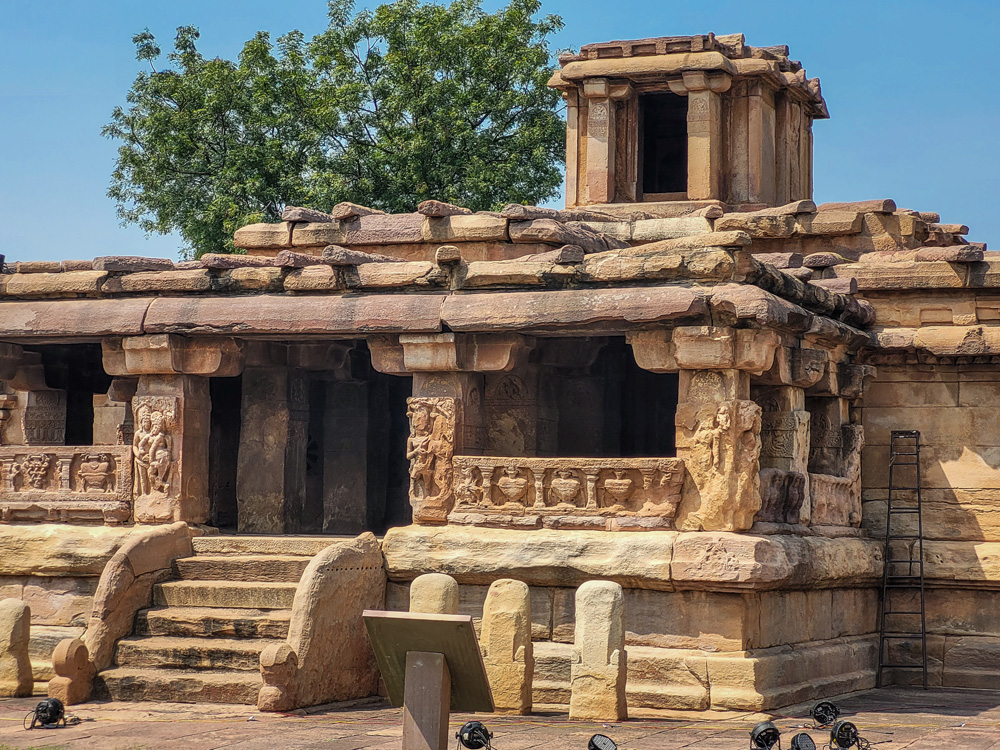
The roof of the temple is decorated with log-shaped stone beams. The sanctum has latticed windows that allow natural sunlight to light the interior. It was dedicated to Shiva. A large Nandi with a pleasant disposition is situated at the center.
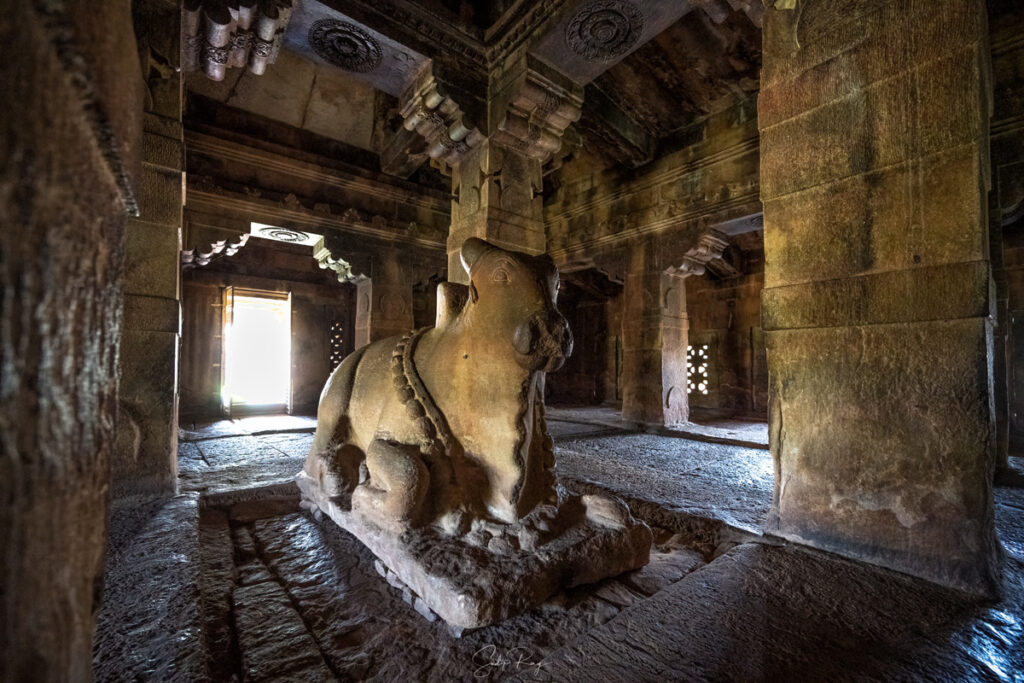
The ‘sabhamandapa’ has beautiful sculptures, showcasing both religious figures and scenes from day-to-day lives. The Chalukyan royal emblem is also carved on one of the pillars.

The specialty of Lad Khan Temple is the small rooftop shrine and a stone ladder set up in the mandapa which once gave access to it.

Suryanarayana Temple:
This smaller temple is built in Nagara style and has a pleasant Surya statue inside the sanctum.
Gaudargudi Temple:
This temple is believed to be the oldest in the Durga Temple complex. It appears from an inscription inside the temple that it was dedicated to Gauri.
Archaeological Museum:
This museum displays many interesting artifacts which have been excavated from various places of Aihole. Don’t miss the fascinating statue of Lajja Gauri, showing the goddess in a birthing position, and a richly engraved panel showing Ambika sitting beneath a flowering tree, taken from the Jaina temple of Meguti Hill.
The Ambigergudi Complex:
This complex is located just across the Durga Temple complex. We noticed around three temples inside. However, the gate was locked and we couldn’t explore.
Chikkigudi:
This is located near the Ambigergudi complex and is of great artistic interest. Alas! This temple was also closed.
Ravanaphadi Cave:
This riveting cave temple belongs to the early phase of Early Chalukyan architecture. It was dedicated to Shiva.
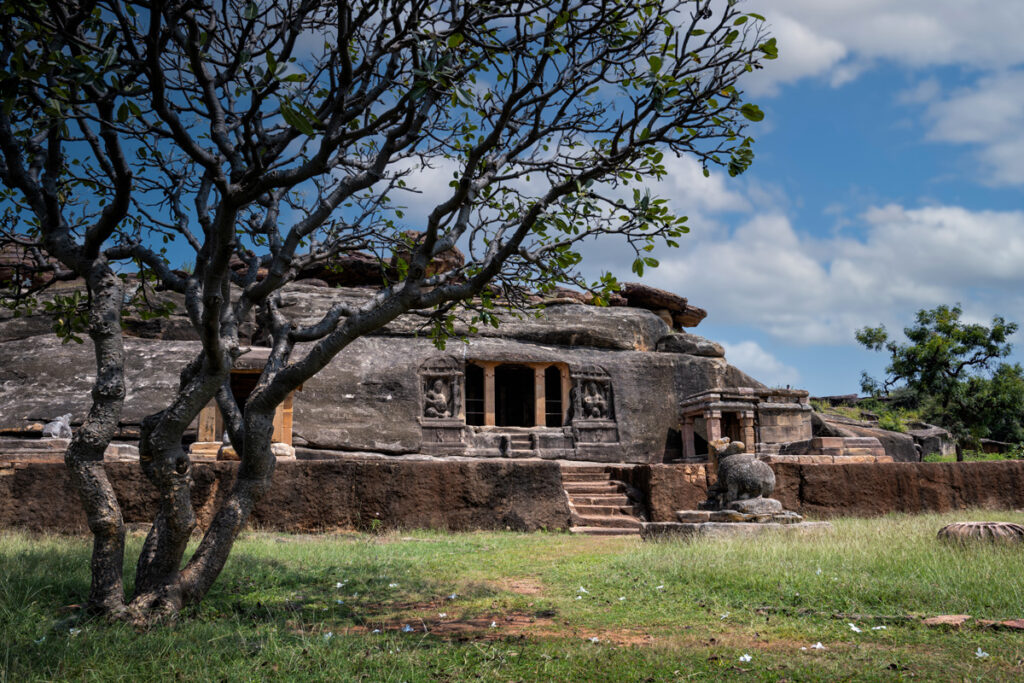
The most intriguing panel of Ravanaphadi shows a ten-armed Shiva in a dancing pose. He is accompanied by Parvati, Ganesha, Karthikeya, and Saptamatrikas. The figures are mind-blowing for their slender proportions, pleated dresses, and intricate jewelry.

The other mentionable carvings are those of Varaha, Mahisasuramardini, Harihara, the descent of Ganga on earth, and Ardhanarishwara clutching a trident.
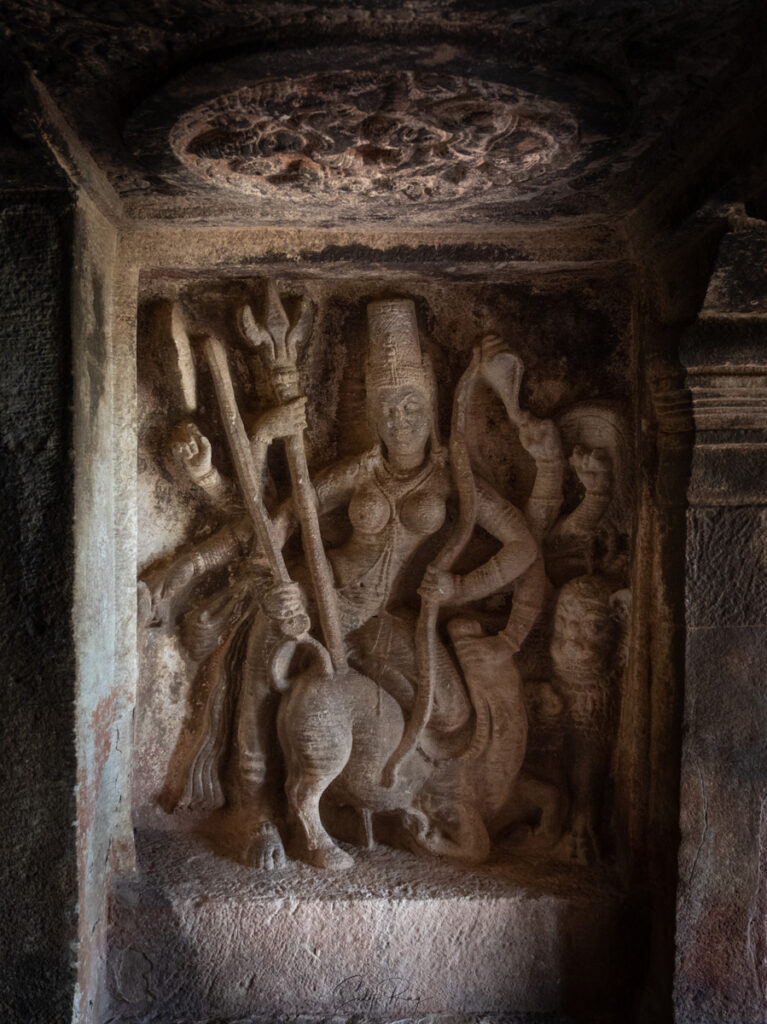
The cave is however incomplete. It is evident from the blank right wall filled with scooped notches.

Hucchimalligudi Temple:
This is another masterpiece of Early Chalukyan architecture. It has a well-preserved Nagara-style tower. The exterior is blank. The most attractive piece of work is on the ceiling near the entrance. It shows Karthikeya flying through the air on a peacock.
Meguti Hill:
This hill houses a Buddhist temple and a Jaina temple. The Jaina temple is of considerable importance as Aihole Prasasti of Chalukya Pulakesin II, which was composed by his court poet Ravikirti, is engraved on one of the temple’s outer walls. The Meguti Hill has some Megalithic Dolmens also.
Mallikarjuna Complex:
This temple complex is situated just at the foot of Meguti Hill. The main temple has a pyramidal tower and belongs to the Early Chalukya period. The lesser shrines were built in the Later Chalukyan years.
Hucchappayamatha:
This temple was closed too. Thankfully, our guide made some inquiries and got the key from a neighboring house!

This small temple may be small, but the carvings are top-notch. The entrance is graced by beautiful sculptures of human couples. The interior has three ceiling panels. They depict Vishnu on Adisesha, Shiva-Parvati on Nandi, and Brahma on a swan.
The temple worshipped Shiva, as evident from the Nandi placed in the center of the mandapa.
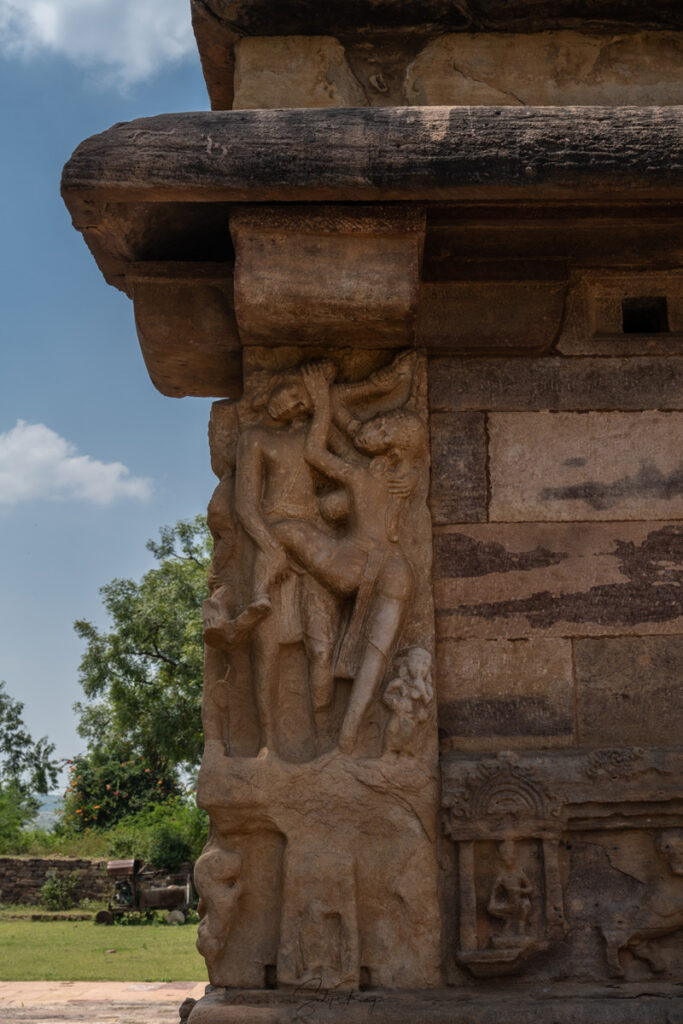
Apart from these main temples, Aihole has countless other structures such as the Kunti Group, Rachigudi, Hucchappayyagudi, Veniyavur Temple Complex, Galganatha Complex, and so on.
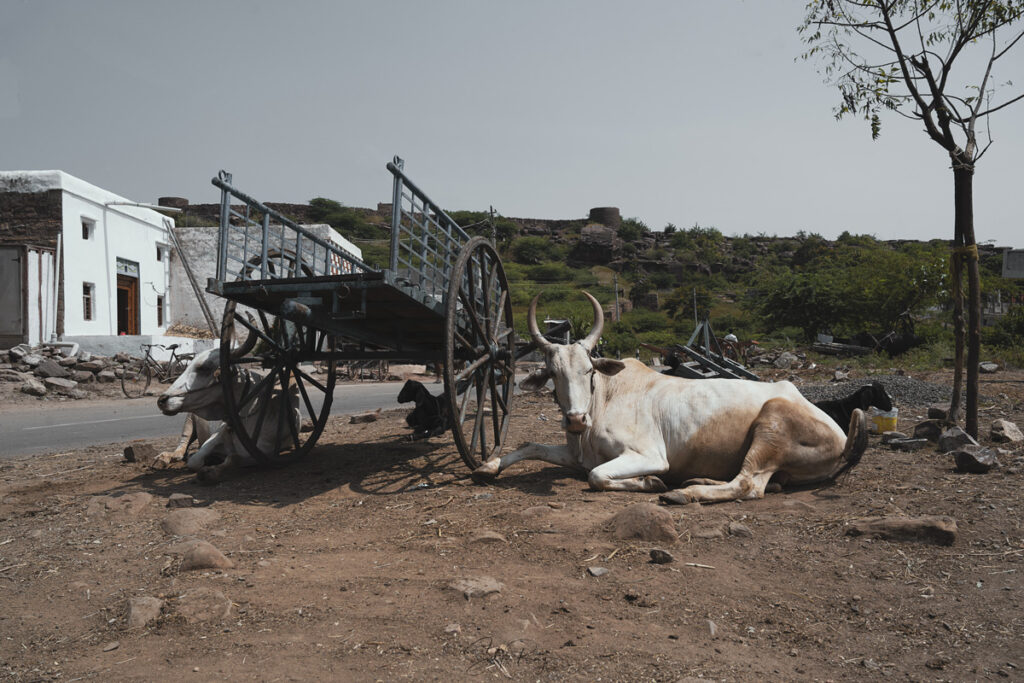
Know before you go:
1. The Durga Temple Complex has entry fees. It includes a ticket for the museum.
2. We strongly suggest taking a guide for traveling in Aihole. There are hundreds of temples, most without any idols inside. Without a guide, chances are you will be unable to understand the architecture, sculpture, and significance. Unless you know what’s what, you will fail to appreciate the heritage of Aihole. One of us has a post-graduate degree in History and both of us went through George Michell’s book on Aihole thoroughly before taking this trip. Still, we took a guided tour. And, we are thankful for that. We had hired him for the entire day for covering Aihole, Pattadakal, and the Cave Temples of Badami.
3. The Durga Temple Complex remains open from 9 AM to 6 PM. Try visiting it at the opening hours. Visitors will be next to nil. The other temple complexes mostly remain empty.
4. We further suggest taking packed food or dry food in case you are planning for a whole-day trip. Aihole is a small village. There are not many options for dining.
5. Stalls selling mineral water and coconut are however in ample number.
6. Washroom is available inside the Durga Temple Complex.
7. Try dressing modestly. The places of interest are all religious in nature.
8. Carry an umbrella, hat, and sunglasses. The sun is quite harsh in Aihole after 12 noon.



